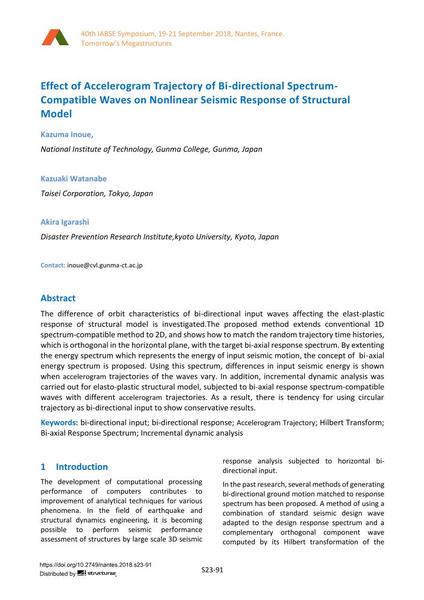Effect of Accelerogram Trajectory of Bi-directional Spectrum- Compatible Waves on Nonlinear Seismic Response of Structural Model

|
|
|||||||||||
Détails bibliographiques
| Auteur(s): |
Kazuma Inoue
(National Institute of Technology, Gunma College, Gunma, Japan)
Kazuaki Watanabe (Taisei Corporation, Tokyo, Japan) Akira Igarashi (Disaster Prevention Research Institute,kyoto University, Kyoto, Japan) |
||||
|---|---|---|---|---|---|
| Médium: | papier de conférence | ||||
| Langue(s): | anglais | ||||
| Conférence: | IABSE Symposium: Tomorrow’s Megastructures, Nantes, France, 19-21 September 2018 | ||||
| Publié dans: | IABSE Symposium Nantes 2018 | ||||
|
|||||
| Page(s): | S23-91 | ||||
| Nombre total de pages (du PDF): | 9 | ||||
| DOI: | 10.2749/nantes.2018.s23-91 | ||||
| Abstrait: |
The difference of orbit characteristics of bi-directional input waves affecting the elast-plastic response of structural model is investigated.The proposed method extends conventional 1D spectrum-compatible method to 2D, and shows how to match the random trajectory time histories, which is orthogonal in the horizontal plane, with the target bi-axial response spectrum. By extenting the energy spectrum which represents the energy of input seismic motion, the concept of bi-axial energy spectrum is proposed. Using this spectrum, differences in input seismic energy is shown when accelerogram trajectories of the waves vary. In addition, incremental dynamic analysis was carried out for elasto-plastic structural model, subjected to bi-axial response spectrum-compatible waves with different accelerogram trajectories. As a result, there is tendency for using circular trajectory as bi-directional input to show conservative results. |
||||
